Key Points:
- Lake Jocassee is located in Oconee and Pickens counties in the extreme northwest reaches of South Carolina.
- Some areas of the lake reach over 350 feet deep, making this the deepest lake in the state.
- In 1973, a partnership between the state and Duke Energy led to the construction of Lake Jocassee. Its purpose was to generate hydroelectric power and provide flood control.
There are 14 major lakes in South Carolina, all of which are man-made reservoirs. The largest of them all is Lake Marion, at over 110,000 acres. But, while Lake Marion is the largest lake in the state, it is not the deepest. That title goes to Lake Jocassee. With some parts of the lake reaching over 350 feet deep, Lake Jocassee is the deepest lake in South Carolina.

Lake Jocassee
Lake Jocassee is located in Oconee and Pickens counties in the extreme northwest reaches of South Carolina. In 1973, the state and Duke Energy collaborated to construct a facility with the intention of generating hydroelectric power and providing flood control. With the completion of Lake Jocassee Dam, they flooded 7,565 acres of the Jocassee Valley, giving birth to Lake Jocassee.
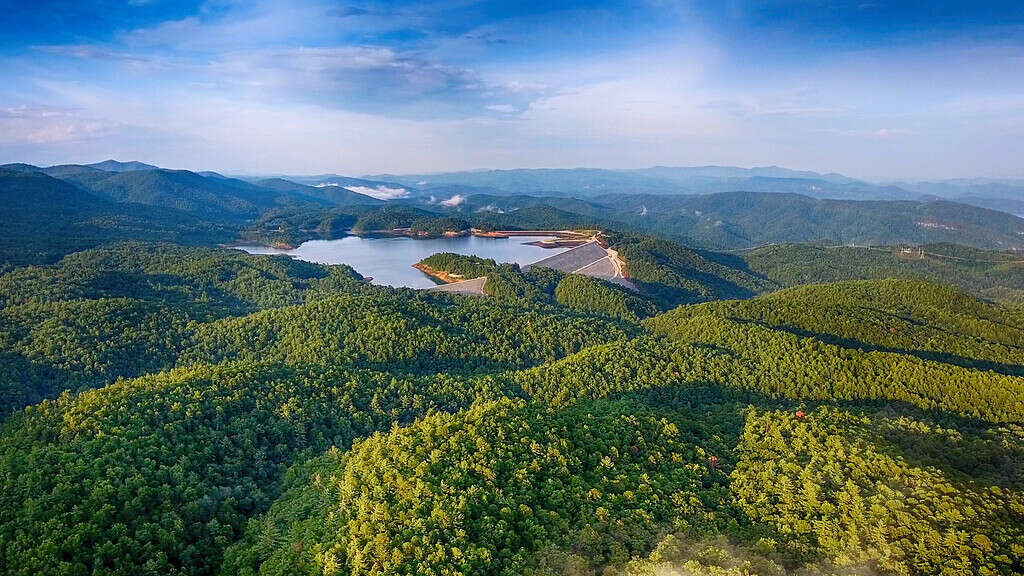
Lake Jocassee, a mountain lake, is the deepest lake in South Carolina.
©iStock.com/Wirestock
The lake features 75 miles of shoreline and has an average depth of 154 feet. It is nestled in the foothills of the Blue Ridge mountains. The surface elevation of Lake Jocassee is 1,100 feet.
The land around the lake remains largely undeveloped. The 50,000-acre Jocassee Gorges Wilderness Area surrounds the reservoir. This protected land boasts lush forests and one of the highest concentrations of waterfalls in the eastern United States. Many of the waterfalls that cascade into Lake Jocassee are only accessible by boat. The wildlife management area is also home to Sassafras Mountain, the highest point in South Carolina.

The waterfalls of Lake Jocassee are only accessible by boat.
©iStock.com/digidreamgrafix
A Clear Water Lake
Lake Jocassee nestles within the Appalachian temperate rainforest. The waterfalls, along with the clear, chilly waters of the Appalachian Mountain Rivers, nourish it. The primary tributaries contributing to the lake include the Toxaway, Horsepasture, Thompson, and Whitewater Rivers.
Thanks to these pristine mountain rivers, Lake Jocassee holds the dual distinction of being both the deepest and the clearest lake in the state. Visibility fluctuates between 20 to 50 feet. People often draw comparisons between the clarity of this lake and the waters of the Caribbean, although Jocassee’s waters are significantly cooler than their tropical counterparts.

Lake Jocassee is fed by four Appalachian Mountain rivers that flow into the lake from the north.
©Clemson3564 / Public domain – License
Scuba Diving
The clear waters of Lake Jocassee have given rise to a rather unusual activity in the mountains: scuba diving. Divers can glimpse the underwater remnants of old-growth forests that succumbed to the flooding upon the dam’s completion. Despite the widespread demolition of most structures before the lake’s creation, some buildings remained. Now, the waters of Lake Jocassee shroud dozens of houses and even a hotel.
The 1972 film Deliverance shows the Lake Jocassee Dam in construction. The Mount Carmel Baptist Church Cemetery, another feature in the movie, now lies submerged beneath more than 130 feet of water. The video below shows you can view the cemetery while scuba diving.
Devils Fork State Park
Public access to the lake is only through Devils Fork State Park, the most visited state park in South Carolina. There are three public boat ramps in the park.
The park features 59 standard campsites for RVs and tents and 25 additional sites that are tent-only. There is also a separate campground with 25 primitive sites that are only accessible by boat.
If camping isn’t your thing, there are also 20 fully-equipped lakeside villas available for rent.
Parking is limited within the park. If you are just visiting for the day, plan to arrive early.
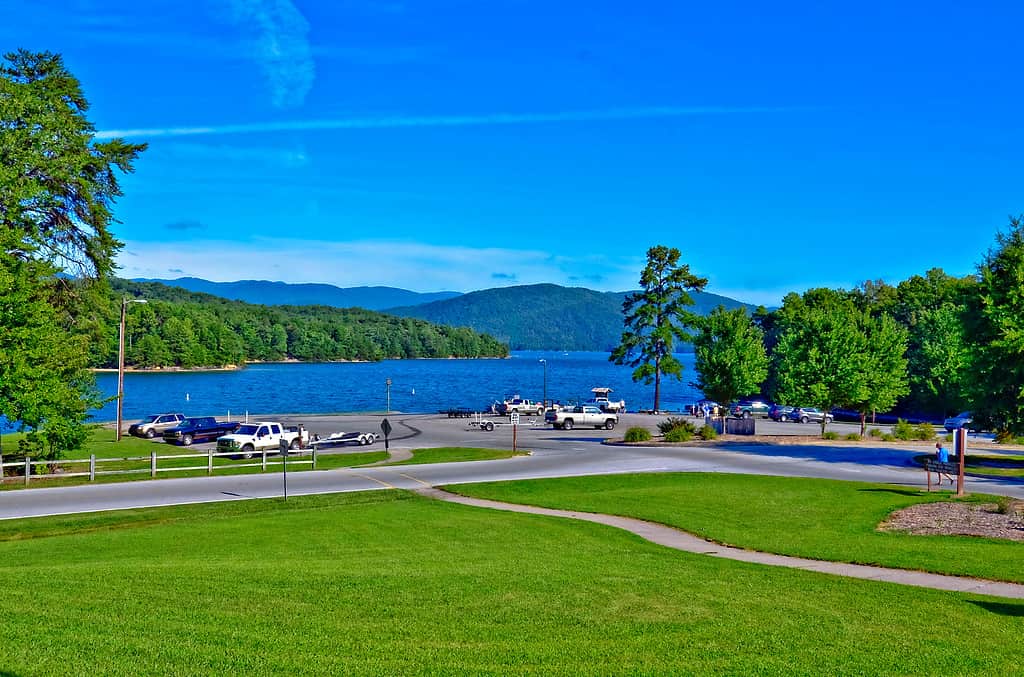
Devils Fork State Park is the only public access point for Lake Jocassee.
©SUSAN LEGGETT/Shutterstock.com
Fishing in Lake Jocassee
Lake Jocassee is one of the premier fisheries in South Carolina. The cool mountain waters allow trout to thrive. Lake Jocassee is one of the few trout lakes in the state and features some of South Carolina’s best trout fishing.
Along with trout, anglers can hook into big largemouth, smallmouth, spotted, and redeye bass. The lake is also an excellent fishery for white and black crappie, channel and flathead catfish, and all manner of panfish.
Five current South Carolina fishing records were set on Lake Jocassee. In 2001, the lake yielded state records for spotted bass (8 pounds, 5 ounces), smallmouth bass (9 pounds, 7 ounces), and redeye bass (5 pounds, 2.5 ounces)
The lake was also the site for the state record for brown trout (17 pounds, 9.5 ounces) in 1987 and rainbow trout (11 pounds, 5 ounces) in 1993.
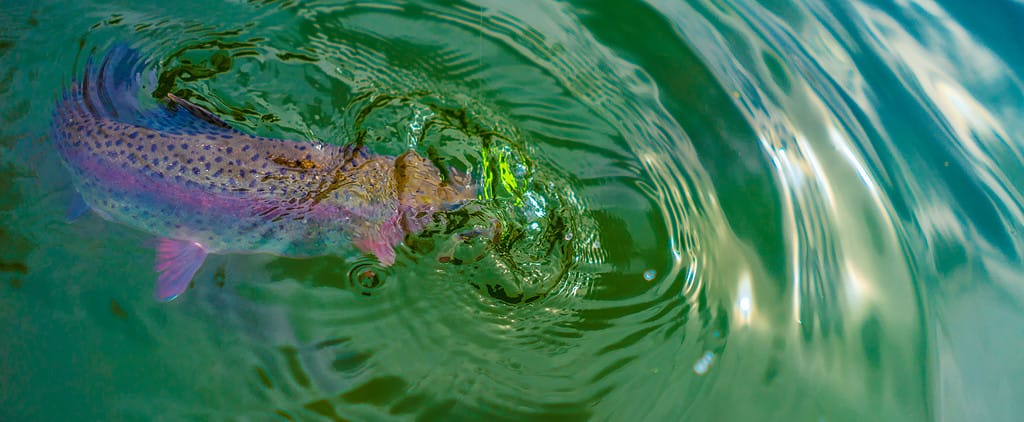
The cold, clear water of Lake Jocassee makes it a great place to hook into a big rainbow trout.
©moonka_pr/Shutterstock.com
Boating
Lake Jocassee is a boating Mecca in South Carolina. All types of boats are permitted. Pontoon boats, bass boats, and ski boats are common on the lake. Water skiers and tubers are often seen skimming across the lake’s surface during the summer. With few “no wake zones,” much of the lake’s 7,500+ acres invite boaters to crank up the outboard and punch the throttle for some serious speed.
If fast isn’t your speed, though, the lake also invites slower, more relaxed aquatic transports. It is a perfect lake for sailboats. Kayaks, canoes, and paddleboards are also very popular on the ultra-clear waters of Lake Jocassee.
All motorized boats must be registered with the South Carolina Department of Natural Resources. Non-motorized boats do not require registration.
If you don’t own a boat, rental companies can be found outside of the Devil’s Fork State Park boundaries. Guided boat tours are also available.
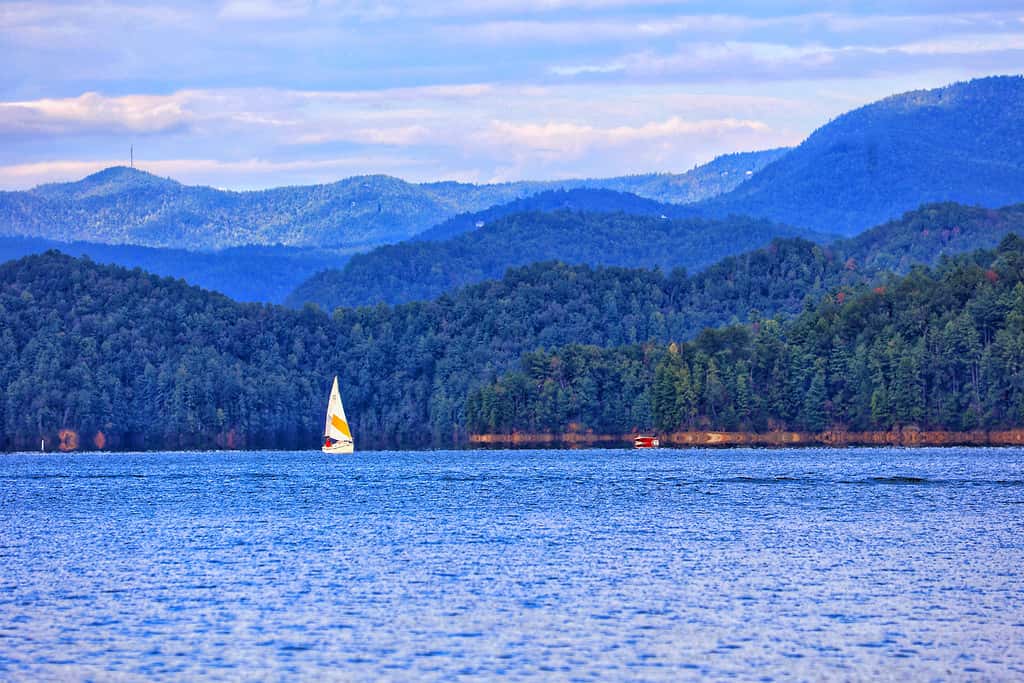
Boating is one of the most popular activities at Lake Jocassee.
©Tara Ballard/Shutterstock.com
Wildlife
The Jocassee Gorges Wilderness Area is filled with wildlife. The area contains the highest concentration of black bears in the state.
Hunters target wild turkeys and white-tailed deer in the Gorges area.
Common loons may seem like a strange sight in South Carolina. These waterbirds are typically found on lakes and in the marshlands of the northern U.S. and Canada. However, these birds overwinter on Lake Jocassee. Their beautifully haunting calls can be heard until April when they grow their summer plumage and fly north.
Some of the other animals visitors may spot include bald eagles, rabbits, mourning doves, bobcats, skunks, raccoons, squirrels, foxes, various waterfowl species, salamanders, snakes, beavers, muskrats, opossums, feral hogs, coyotes, groundhogs, minks, and river otters.

Common loons overwinter at Lake Jocassee.
©iStock.com/BrianLasenby
Wildflowers
The flora of the Jocassee Gorges area is spectacular, including the Oconee Bell. This lovely wildflower is found nowhere else in the world. The flower was discovered by French botanist, André Michaux, in 1788.
The Oconee Bell grows only in the Jocassee area and a few counties in the North Carolina foothills. The wildflower blooms from mid-March to early April. Visitors to Devil’s Fork State Park can normally find these unique flowers in abundance in early spring.
The area also features some ferns and mosses that are typically only found in tropical Central America. These plants flourish in the area due to the plentiful rainfall of the Appalachian temperature rainforest combined with the shaded habitats provided by the steep river gorge walls.
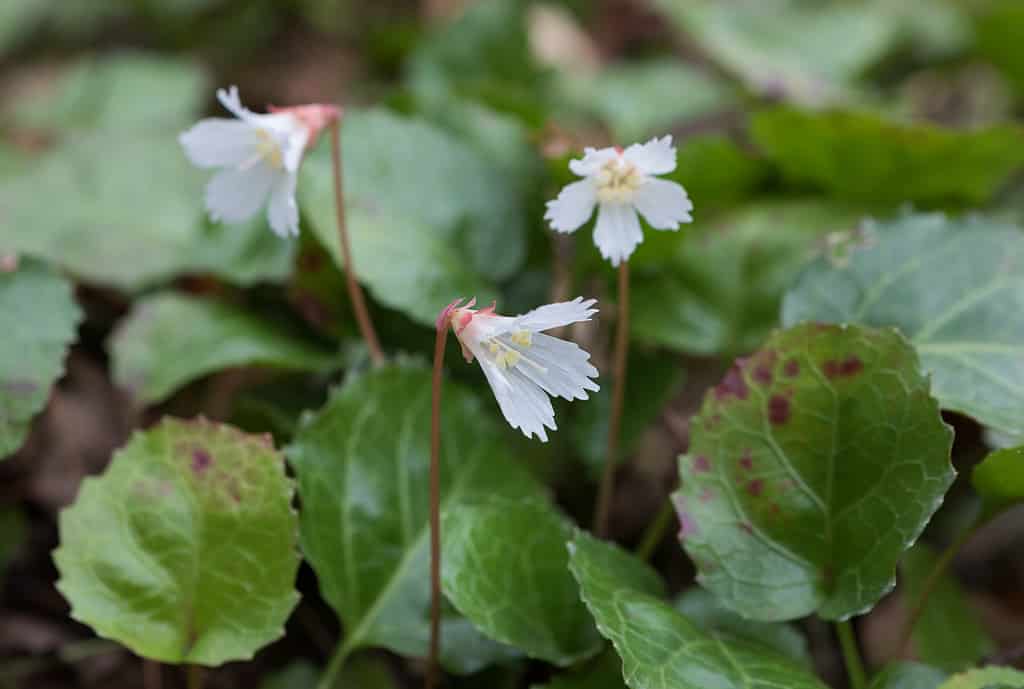
The Oconee Bell is a delicate, rare wildflower found in Devils Fork State Park from mid-March to early April.
©Cvandyke/Shutterstock.com
Cherokee History
Jocassee is a Cherokee word meaning “Place of the Lost One.” The Jocassee Gorges area was once occupied by the Cherokee Nation. After the American Revolution, the Cherokee were forced to cede much of their land to the United States.
In 1785, General Andrew Pickens led a large gathering of Cherokee chiefs. The chiefs signed over ownership of much of the Jocassee Gorges area. The Cherokee people would eventually cede the Oconoee County Mountains to the U.S. in 1815.
The photo featured at the top of this post is © digidreamgrafix/Shutterstock.com
Thank you for reading! Have some feedback for us? Contact the AZ Animals editorial team.






